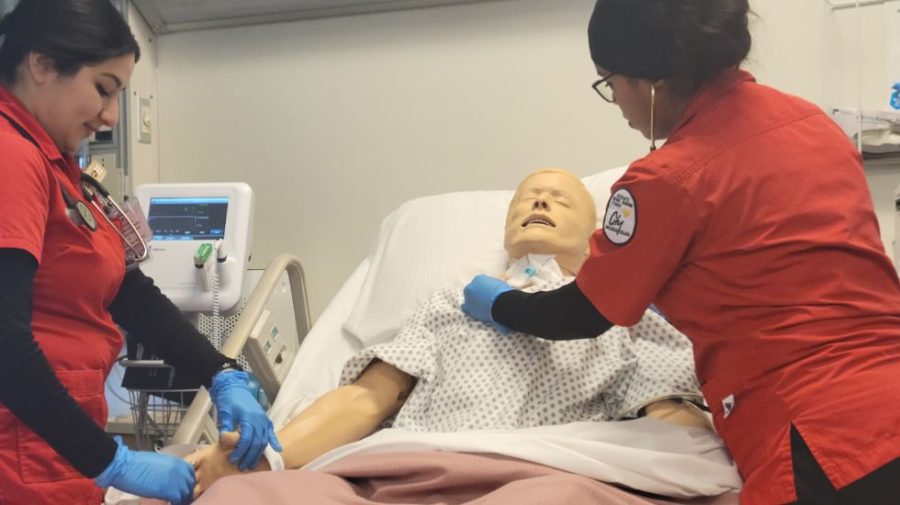City College shaping future of nursing students through hands-on training, instruction
City’s nursing program, led by Dometrives Armstrong, is one of the top-ranked programs in the country
Nursing students Ashley Watson, right, and Berenice Carrasco, left, practice on mannequin, April 25, 2023. Photo by Shamere Grimes/City Times Media
April 27, 2023
Correction: The names of nursing students Ashley Watson and Berenice Carrasco were misspelled in earlier editions of this story. They have since been corrected. City Times regrets the error.
Berenice Carrasco, a student in the nursing program at San Diego City College, said going into nursing allows her to give back to her community and other underrepresented community groups.
“I grew up in Barrio Logan and I saw a lot of discrepancies in health care,” Carrasco said.
The nursing program at City College, ranked second best in California and third nationally according to an article published at rncareers.org, provides students with the skills and techniques they’ll need in a very difficult and rewarding field.
Dometrives Armstrong, an alumna of the City College nursing program and the associate dean of nursing, said one of the reasons students should choose the City College nursing program is the faculty.
“We are very diverse and we care for our students,” Armstrong said.
Ashley Watson, a student in the nursing program, felt drawn to City College because of its high pass rates for the National Licensure Examination (NCLEX-RN) and also to diversify the profession itself.
“Latinos only make up about 6% of the population in nursing and so I know that as a Latina myself, I can make an impact not only within the nursing community but also in the Hispanic community,” Watson said.
All nursing programs in the state are monitored by the California Board of Registered Nurses for the NCLEX pass rates over the previous five years. Should a program fail to meet the standard pass rates set, the program itself can be shut down.
Being accepted into the nursing program at City College is contingent upon meeting certain prerequisites and dependent on a multi-point system set up by a California Community College Chancellor’s Office.
City College received roughly 230 applicants this year, with only 70 of them getting in, according to Armstrong, although students who do not get in the first time around can always reapply the following year.
“But the nice thing is about our program, we have a point system,” Armstrong said. “We don’t have a waitlist.”
An article written by the American Association of Colleges Of Nursing estimated the number of baccalaureate-prepared nurses needs to increase by 80% in order to ensure patient safety. The U.S Department of Labor estimates that more 275,000 nurses will be needed from 2020 through 2030.
Armstrong encourages more men to go into the field to allow a different perspective when interacting with patients as well as create a more diverse workforce. According to an article written by Zippia, nursing is a predominantly female career field.
Currently, City College has about 20 male students in a class of 70 enrolled in the program, according to Armstrong.
“I would say that is a 10-15% increase since 2017,” Armstrong said.
At City College, students in the nursing program get hands-on experience working in the field as a part of the curriculum. The students could end up working in hospices, hospitals and other facilities before they graduate.
Toward the end of the Covid-19 pandemic, City College students had the opportunity to administer vaccines in impoverished neighborhoods in San Diego.
Matilda Chavez, the vice president of instruction at City College and the first Latina to hold that role, said her experiences as a student nurse and the struggles and experiences of that point in her life made her who she is today.
“I didn’t know the level of difficulty that came with nursing school,” said Chavez, speaking at the 7th annual City Women Rock Conference last month. “It was like going to a boot camp.”
Chavez worked abroad in Nigeria at nursing clinics one summer while attending a Master’s degree program.
“This is one of the most pivotal points in my life to realize I had some leadership skills,” Chavez said.
Armstrong touched on the importance of students maintaining their mental health and how she maintains her own in a field where nurses are often dealing with a variety of difficulties including challenging patients, a high-stakes environment, and possibly the death of their patients.
“One thing I would tell new nurses in nursing school, having been a nurse for many years, is that your first priority is to take care of yourself,” Armstrong said. “Because if you’re not able to take care of yourself, you won’t be able to take care of your patients.”
A 2020 article written by the AACN addressed a need to enhance racial diversity in the field. The survey concluded that the registered nurse population is made up of 80% Caucasian, 6.7% African American, 7.2% Asian, 0.5% American Indian/Alaskan Native, 0.4 Native Hawaiian/Pacific Islander, 2.1% two or more races, and 2.5% other.
Armstrong hopes to push the nursing program at City College to greater heights to include a bachelor’s program and even study abroad programs. Though she believes those may not occur during her tenure, she acknowledges that they may be possible in the years to come.











